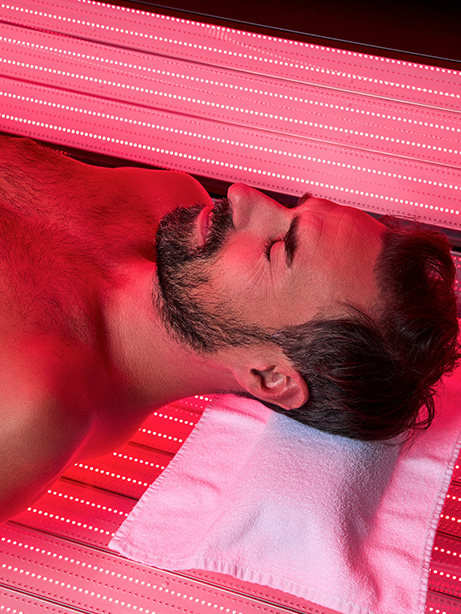

Photobiomodulation: When Light Heals Cells
Michaela Altenberger,
How does light work directly inside the cell – without us feeling anything?
Can wavelengths we can barely see restart our energy production?
And where does the effect end – at the skin’s surface or deep within every cell?
1. What happens inside the cells?

Photobiomodulation specifically uses red and near-infrared light – usually in the range between 600 and 1,100 nanometers – to trigger precise biological reactions. These wavelengths penetrate much deeper into tissue than visible daylight. There, they encounter a key mitochondrial enzyme: cytochrome c oxidase (CCO), a component of the respiratory chain.
CCO functions like a tiny solar panel: it absorbs photons, releases bound nitric oxide molecules, and enables a more efficient electron transport. The result:
- More ATP – the universal energy currency of the cell.
- More nitric oxide (NO) – dilates blood vessels, improves oxygen supply.
- Controlled reactive oxygen species (ROS) – act as signaling molecules for repair and cell protection.
Light-sensitive ion channels also respond, particularly to near-infrared light (e.g., 810 nm). They increase the flow of calcium ions (Ca²⁺) and cyclic AMP (cAMP) – both central messengers that promote cell division, healing, and differentiation.
Studies show that even damaged mitochondria can structurally and functionally regenerate through these impulses – inflammation decreases, cellular stress is reduced, and programmed cell death (apoptosis) is prevented. This is particularly well-documented in models of retinal regeneration and in neurodegenerative processes.
2. Light as a key to energy and healing
What happens when cells suddenly have more ATP available? They repair damaged structures faster, produce more collagen, improve communication, and optimize blood flow. These effects are not limited to the skin – any cell with mitochondria can benefit.
The discovery began in the 1960s with a coincidence: a Hungarian researcher aimed to treat tumors with a ruby laser. The tumor remained unchanged – but the hair of the test animals grew noticeably faster in the irradiated area. This unexpected result laid the foundation for research now applied in dermatology, sports science, and neurology.


3. Context and application at the Krallerhof
At the Krallerhof, we use photobiomodulation in a targeted and customized way:
- Skin regeneration & anti-aging
For guests looking to refine their skin texture or tighten their complexion. The goal is gentle stimulation of collagen production combined with antioxidant effects – often in combination with facial treatments. - Deep regeneration of muscles & joints
For tension, sports injuries, or chronic conditions, usually applied daily to penetrate deep into the tissue. This can shorten healing time, relieve pain, and improve mobility – especially when combined with massage or lymphatic drainage (before the massage). - Sports performance & recovery
Professional athletes use red light to stimulate microcirculation before training – which can lead to more explosiveness and endurance. For recovery, we apply it 1–2 hours after exertion to avoid suppressing the body’s natural inflammatory response. - Sleep & stress programs
In the evening, near-infrared applications can activate the parasympathetic nervous system, lower heart rate, and support melatonin production.
Photobiomodulation is more than just technology – it is a precise dialogue between light and cellular physiology. When applied at the right time, in the right dose, and in the right context, it amplifies the body’s natural healing and regeneration processes.

